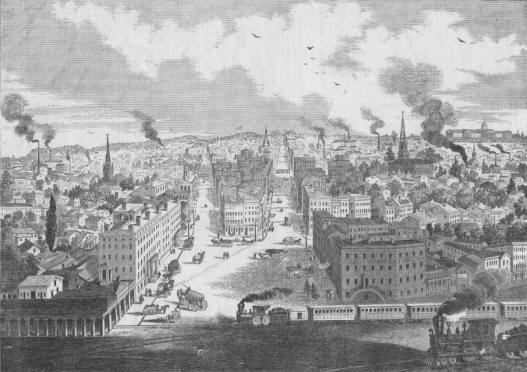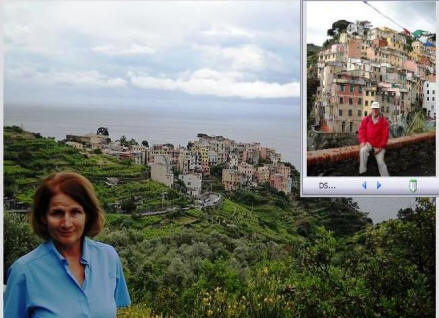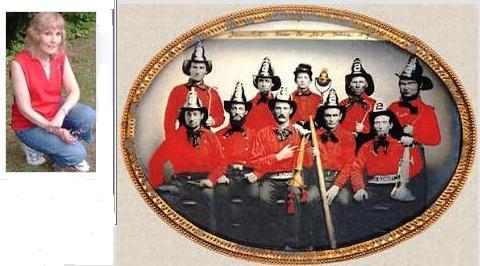Dear Donald,
We have a football (American version) story coming up soon. It will feature the most famous football player in the Jerrems tree. And his namesake is well known to us.
| REMEMBER ME |
Ray Jerrems with Research by Sandra Walcyk

Introduction
This is the story of Joseph Jerrems/Jerrams, who, despite his comparatively early death, had made a significant impact in his adopted community in the USA, far from where he was born in rural England. It is a typical story of the challenges facing people who migrated to foreign lands in the 1800s, I hope you enjoy it.
Joseph throws down the gauntlet
Recently we received a brief Email from Heaven from Joseph Jerrems/Jerrams setting out two challenges for Sandra and Ray. Here is the email:
Dear Sandra and Ray
I have been following the Jerrems Journal for some time and have noticed some brief references to me.
My name is Joseph and I am Sandra’s great great grandfather and Sarah Papageorge’s great great great granfather. I feel that it is time for me to throw down some challenges to you.
My challenges to you are to (a) find out more about me (b) identify which of the men in the attached photograph is me and (c) write an article about my daughters. I will give you a clue on the second challenge, look for a family resemblance with Sandra, whose photo is shown in the August 2008 Journal.
Good luck, and may the force be with you.
I remain etc
Joseph
Why did I write this article?
Although I have ostensibly written this article in response to Joseph’s first and second challenges (I will write about his daughters later), it is in fact a tribute to the hard work carried out by Sandra (pictured with firemen) in researching her family (her family tree now contains almost 2,400 people) and the assistance she has given to me in researching for my articles. Unlike the position for a lot of my articles, where it is likely that further information will come to light, Sandra has exhausted all current avenues of enquiry for her great great grandfather and it is now time to put pen to paper!
Readers will see that although there a lot of gaps in our genealogical information about Joseph, I have drawn on other clues to describe his life in the US.
Who was Joseph?
Joseph Jerrems/Jerrams, came from what we have dubbed the “Wappenham” line of the Jerrems families. Sandra, with the help of Ray Lloyd, has traced that family back to Joseph and Mary Jerroms, Joseph having been born in 1690. This is, incidentally, several decades earlier than we have traced the Gainsborough line.
Joseph was born in 1814 in the village of Wappenham, Northamptonshire. His parents were William and Hannah Jerrems/Jerrams, and he was the second of ten children. He married Sarah Kirby in 1835 and in due course they migrated to the US. It is possible that he got the idea of migrating to the US from his older brother James (see JJ of July 2008), who had migrated to the US some time earlier.
It is very likely that the couple disembarked at New York, which was the major port used by migrants. They chose to settle in Utica, about 250 miles to the north west of New York City. No doubt a major attribute of that area was that it was now comparatively easy to get to from New York City and it had good employment opportunities.

The reason for this ease of access was that they could travel by barge along Erie Canal. The good employment opportunities arose from Utica’s recent growth as an industrial city with a population of about 18,000 in 1849, thanks largely to the Erie Canal which allowed the use of large barges for the importation of materials and the export of finished products to places like New York and transhipment for overseas. Also there were a number of textile mills in the area which supported a clothing industry in Utica.
The couple settle in Utica and Joseph finds work
Unlike his brother James, who settled in the nearby rural villages of Washington Mills and New Hartford and retained an interest in farming, Joseph settled in the city of Utica and soon assimilated into urban life.
The 1850 and 1860 Censuses and the 1858/59 City Directory refer to him as being a carpenter. I assume that he was a carpenter in a factory. He is also referred to in the 1844/5 Directory as a labourer (this is in fact the first specific record we have of him in the US).
Their children
Joseph and Sarah had four (or possibly five) children, the first being a girl (Ann E) born in 1847 and died before 1860 Census, the second (George Washington) was born in June 1850 and died in 1852. Happily the third and fourth children, who survived childhood, were Sarah Cornelia born10/22/1855 or 1856, died Utica 9/9/1915 at the age of about 60 and Anna Susan, born on 6 March 1859 died 1929 at the age of 70. The fifth child (a boy) may have been born in 1846.
This sad ratio of infant deaths was much the same as Joseph’s brother James experienced.
The photograph
Sandra found the photograph of the men in red coats on a website www.photographymuseum.com/amreflect.html, It is an old ambrotype photo of “Franklin Hose Co. No. 5, Utica, NY”. No actual date of the photo is given. It is from an exhibition at the Henry Ford Museum in the year 2000. The ambrotype technology was used from about 1854 to the 1870’s. As you see, there are 10 men shown wearing bright red coats. I have included more information about the Hose Company later in this article.
Financial position
Fortunately Joseph earned sufficient wages to save a substantial amount of money. The 1860 Census shows that they owned real property to the value of $900 and personal property to the value of $200. The value of the real property indicates that they owned a house (as distinct from owning vacant land). This of course helped them to continue saving and was a significant factor later when he died (but this will be in my next story, about their daughter Anna).
Location of house
The 1858/9 City Directory refers to his address as being 143 Water Street, which is a mile north-east of the Utica Post Office and is near the Erie Canal.
The house was well placed for employment, being within walking distance (always a necessity in those days ) of textile factories situated a few blocks to the east of where he lived (the textile mills first started in the early 1800’s in the Washington Mills-New Hartford area and then were established in Utica in the mid-1840’s). Other industries in the general area where Joseph lived were carriage makers, wrought-iron works, potteries, tinsmithies and breweries.
The neighbours shown in the 1860 Census were a factory hand, a clerk, 5 labourers, 2 servants, another carpenter, a widow and a tailoress, indicating that it was a “working class” locality.
Joseph the fireman
Sandra’s newspaper research shows that Joseph was a fireman in 1857, being a member of the Franklin No. 5 Hose Company. It was located in Washington Street, not far from where Joseph lived. In those days this would have been voluntary (this situation still applied in Sydney until the Second World War), and shows that Joseph was very civic minded.
It also indicates that he worked close by because members of the fire team had to get to the depot as quickly as possible when the alarm sounded, to pick up their equipment. In Sydney the alarm was a loud bell. My father told me of the dramatic response to the ringing of the bell in his neighbourhood. Members of the crew rushed out of their houses and shops and ran down the street to the depot, the butcher taking off his apron as he ran, leaving his customers in the hands of the apprentice.
This was a dangerous job, exacerbated by their lack of real safety equipment. To state the obvious they would have been required to go to fires at all times of the day and night, regardless of weather, on top of their long work hours and family duties. Added to this, the job would have been physically demanding, particularly for a man in his early 50s, like Joseph. In the 1850s they would have had a hand-operated pump, hoses and small tanker, all mounted on a cart which they probably pulled along themselves.
Fires were very common
As with all cities and towns of the time most houses and buildings were made of timber, which were very vulnerable to fire. The main causes of fires in houses would have been the use of open fires for heating and lamps for lighting. Brick and stone houses were less likely to catch fire from internal causes but were still burnt down if a lot of adjacent timber buildings were on fire.
Famous major fires which come to mind are the Great Chicago Fire in 1871 (when over 300 people perished and 90 000 were left homeless), and the 1906 San Francisco Fire (preceded by a number of fires which burnt out the city in the previous 50 years) where at least 700 people died, 28,000 buildings destroyed and 300,000 left homeless. The statistics demonstrate the prevalence of fires and the dangerous role of firemen.
One smaller fire involving the Jerrems family was a fire which brought the Bowery (in New York) to a standstill. In 1887 the “Nicoll the Tailor” factory, which took up much of a city block, caught fire in a spectacular blaze. Nicoll the Tailor was of course the great grandfather of our editor and his photo was in the December 2008 and January 2009 Journals. The fire received newspaper headlines, particularly because three of the huge crowd of spectators were killed in a bizarre accident which I will tell you about in a later article.
More locally to me, one of my grandfather’s houses (a two storey timber residential house) was burnt down in the early 1900s.
Other community interests
In addition to his role as a fireman Joseph was a member of the Whig Party (a predecessor of the Republican Party). As recorded in the local newspaper, at one Whig meeting in 1854 he was elected as a delegate to the Whig Primary Elections. Sandra has deduced that, because the next presidential election was in 1856, his role could possibly have had something to do with Presidential Primaries where Presidential candidates are chosen to run (I am sure that our American readers will understand what this means).
It is probably a measure of Joseph’s ability and standing that he was elected to this position.
It is also likely that Joseph and Sarah belonged to a local Church congregation.
Social standing
It should be borne in mind that Joseph came from a rural working class background, and worked later in Utica as a carpenter. Normally this would have defined his social status. However, at the time Joseph settled in Utica, these social barriers would have been breaking down in USA cities like New York and Chicago so that the working class could have become shopkeepers and even businessmen (a case in point being Nicoll the Tailor who started as a tailor and built up an empire). Perhaps this dilution was occurring in Utica also.
Despite his modest beginnings I feel that Joseph was held in high regard throughout the Utica community, a factor that was later to become very significant for his family. I base this on the fact that when his wife Sarah died little Anna was taken in by the prominent (and wealthy) Root family. At the time this family included a College professor, whose brother was a lawyer (formerly a judge) in Utica. In addition two daughters had married Church ministers. Subsequent members of the family included a lawyer (who was later made a Nobel Laureate) and another College professor (I referred to some of these in my article in the Journal of November 2008).
In those days there was a high incidence of early deaths of parents from various causes, resulting in many children becoming orphans who were put into institutions if they could not be taken in by their extended family. There would have been facilities for orphans in community “work houses” in Utica at the time, and shortly afterwards during the post-Civil War period orphanages were specifically set up to cater for the growing numbers of orphans caused by that War. A case in point was the House of the Good Shepherd which started in Utica in 1873.
Normally the girls would have been put into such institutions, but in little Anna’s case she was taken in by the Roots. This type of placement was very unusual.
Death of Joseph, location of grave
We do not know exactly when Joseph died, but it would have been later than the 1860 Census (where he was listed) and at least a year before 1865, when his widow Sarah died.
Similarly we do not know specifically where he was buried, but there is a strong chance he was buried in the nearby Potter Street Cemetery, which was closed in the late 1800s. Our reasoning for this is that their first child is recorded as having been buried in that cemetery, where a family plot may have been purchased.
Joseph’s funeral would no doubt have been an impressive affair, obviously tempered by sadness that he had left a widow and young family behind. We can picture the firemen, resplendent in their uniforms, forming a guard of honour, and his fireman’s helmet sitting on the coffin. His fellow Whig Party members and factory workers, in addition to the Church congregation, would have turned out in force, assisting Sarah financially by “passing the hat around” for donations.
All this would have been quite a pageant for the little girls. Young Sarah, aged between 5 and 8, would have understood that she would not be seeing her father again, but Sandra’s great grandmother Anna, being either a baby or not much more than a toddler, would have been oblivious to this.
Death of Joseph’s wife Sarah
Sarah died on 8th August 1865 in very sad circumstances. She died from dropsy (a term used for oedema or swelling) and consumption (now known as tuberculosis) in what would have been a lingering and painful death. The effects on the little girls (Sarah aged about 8 and Anna aged 6) of losing their parents in fairly quick succession, exacerbated by seeing their mother dying in this manner, must have been devastating.
One fortunate aspect for the little girls in the long term was that Sarah, no doubt knowing that she was dying, had a will made up professionally to ensure that (as far as was possible) the girls were provided for to some extent from a financial viewpoint.
Conclusion
Well, I think we have met Joseph’s first challenge of finding out more information about him, but I am still trying to detect a family resemblance between any of the men in the photograph and Sandra. How did you fare?
I will email Joseph back to say that I will write about his daughters later, in reply to his third challenge.
| Preview of Coming Attractions |

Who is the Jerrems in this picture?
We will tell you in a future edition!
| Jerrems Picture Travelogue |
Donald Jerrems, Editor
Summer Travels

My beautiful Florida-born sister, Susan, and her French-born husband, Didier, visited northern Italy this summer.
The Cinque Terre is a rugged portion of the northern coast on the Italian Riviera. “The Five Lands” comprises five villages: Monterosso al Mare, Vernazza, Corniglia, Manarola, and Riomaggiore.
Above are two images from hundreds taken.
If you have a Travelogue picture, send it in.

